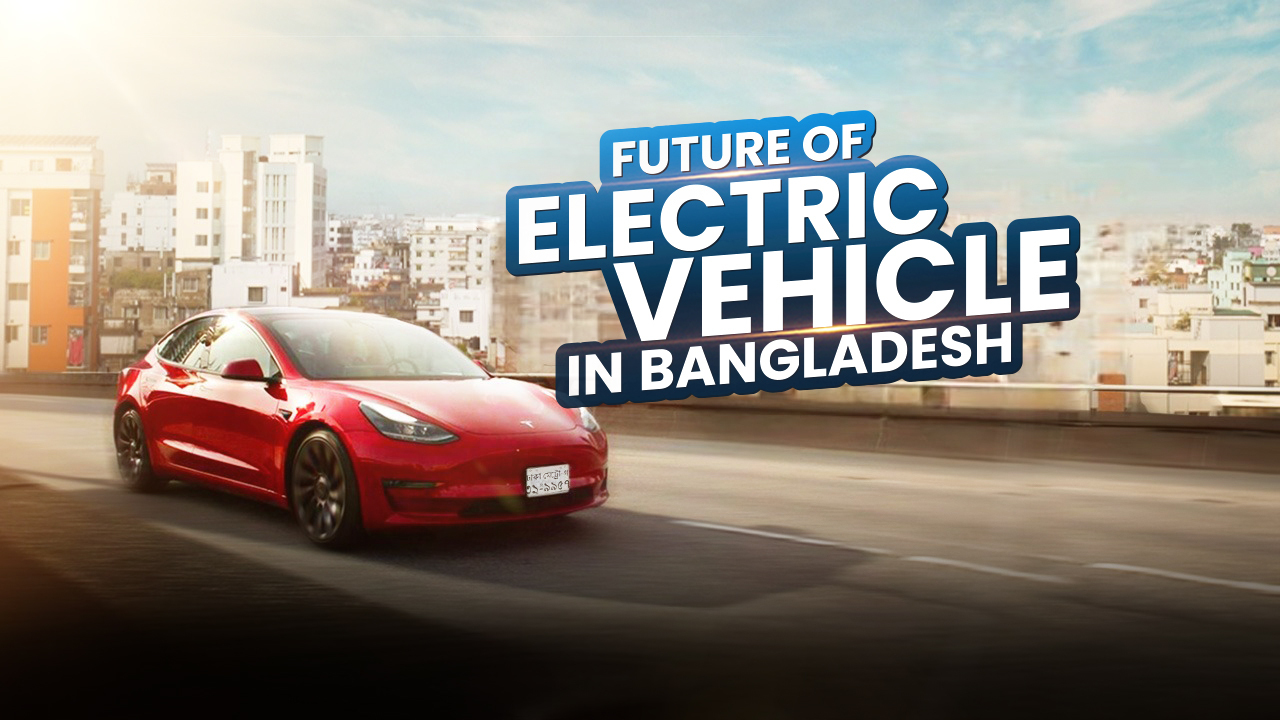The global adoption of electric vehicles is on a steady rise. In 2022, over 10 million electric vehicles were sold worldwide, making up 14 percent of the total vehicle sales for that year. As of 2022, there are in excess of 26 million electric vehicles traversing roads across the globe. Governments and corporations from various countries are implementing diverse initiatives to achieve net-zero carbon emissions globally by 2050. Consequently, global automobile manufacturers are shifting their focus towards the production of fully electric vehicles. In Bangladesh, the consumer trend towards purchasing hybrid and plug-in hybrid cars has seen a significant increase in recent years. A number of electric vehicles have already made their appearance in the country. Notably, the German brand Audi has officially introduced its electric vehicle model in Bangladesh. The question now arises: Is the automobile market in Bangladesh prepared for the adoption of electric vehicles?

Overview
Between 2011 and 2021, Bangladesh saw a growth rate of over 7 percent in the number of passenger cars. Data from the Bangladesh Road Transport Authority (BRTA) reveals that there are more than 400,000 registered passenger cars as of March 2023. Nearly half of these were registered in the last decade. The growth of the automobile industry in Bangladesh is largely due to increased purchasing power among customers. For many years, customers in Bangladesh preferred reconditioned Japanese domestic market (JDM) cars. The Bangladesh Reconditioned Vehicles Importers and Dealers Association (BARVIDA), reports that over 14,000 JDM cars were imported into Bangladesh in the 2021-22 fiscal year.
| Fiscal Year | Number of Imported Cars |
| 2018-19 | 12502 |
| 2019-20 | 13258 |
| 2020-21 | 14438 |
| 2021-22 | 14077 |
However, recent years have seen a shift in this trend. In 2016, reconditioned cars made up 92 percent of total car imports, while brand-new cars accounted for only 7 percent. By 2020, imports of reconditioned cars had fallen to just 18 percent. The remaining 82 percent were brand new vehicles, with 16 percent imported and 2 percent assembled locally. The growing trend of buying brand-new cars has led to an increase in automobile assembly in the country. Sales of brand new cars in Bangladesh are on the rise. Customers are also buying hybrid and plug-in hybrid vehicles. The National Board of Revenue reports that around 3,300 hybrid cars were imported into Bangladesh in fiscal year 2018, a figure that rose by over 150 percent to about 8,400 units in fiscal year 2020-21. Popular hybrid models in Bangladesh include Toyota Aqua, Prius, CHR, Axio, Noah, Harrier, Honda Vezel, Grace, and Nissan X-Trail. Customers choose hybrids for their performance, fuel efficiency, and relatively low VAT despite lower cc engines. Since EV registration began in Bangladesh in September 2022, 20 EVs have been registered with the BRTA.

Future of EV in Bangladesh
The Bangladesh government aims to reduce carbon emissions in the transportation sector by 3.4 million tons by 2030. This goal requires at least 30 percent adoption of electric vehicles in the country. However, the infrastructure for EVs is still under development. The BRTA has finalized the Electric Motor Vehicle Registration and Operation Guidelines 2023 and the tax rate for electric vehicles. Under these guidelines, all types of electric vehicles will be registered under the E or EV categories. Like combustion engine cars, electric cars will require registration, fitness certificates, tax tokens, and route permits to operate on roads. The registration fee will depend on the motor capacity (kW) of the vehicle. According to Bangladesh’s policy for annual electric vehicle taxes, the tax has been fixed at 1 kW per 20 cc.
| Engine or Motor Capacity (1 kw = 20cc) | Tax (BDT) |
| Up to 1500 or 75kw | 25,000 |
| 1500 – 2000 or 75-100kw | 50,000 |
| 2000 – 2500 or 100-125kw | 75,000 |
| 2500 – 3000 or 125-150kw | 1,25,000 |
| 3000 – 3500 or 150-175kw | 1,50,000 |
| Above 3500 or 175kw | 2,00,000 |
The duty structure for electric vehicle imports is yet to be finalized in Bangladesh. Currently, the total tariff and tax incidence on EV imports ranges from 85 to 96 percent. For instance, the base model of the Audi e-Tron EV is priced at $70,000 to $72,000. In Bangladesh, the starting price for this car is BDT 1.59 crore. After calculating the dollar exchange rate and various taxes like customs duty, regulatory duty, VAT, and advance income tax, the total tax incidence on this car is around 95 percent.

In January 2023, Audi established Bangladesh’s first EV charging station in Dhaka’s Tejgaon area. All types of electric vehicles can charge here. Apart from this, there are no other EV charging stations available yet in Bangladesh. The government has already finalized a policy for setting up charging stations, including initiatives for new charging stations and battery recycling facilities.
Private organizations can also set up charging stations as per the policy. Authorized EV dealers and importers provide support for home charging unit installation. Full electric cars can travel 300km on a single full charge. Dhaka, the world’s sixth largest city spanning 306 square kilometers, is 20-50 kilometers from Savar, Gazipur, Narayanganj, and Munshiganj. Given Dhaka’s traffic, regular commutes within these districts would allow most fully charged EVs to run for 3-4 days without recharging. This suggests that Dhaka is already prepared for customers to use EVs regularly.
Moreover, EVs can travel to faraway divisions or districts outside Dhaka with one charge. The distances from Dhaka to major cities in the divisions of Sylhet, Chittagong, Barisal, Rajshahi, Khulna, and Mymensingh range from 100-250 km – within the single charge range of most EVs. Nearly every EV maker provides a portable charger with the vehicle that customers can carry. This allows charging from a regular wall socket, available at homes, hotels, and more.
Portable chargers can do both level one and level two charging. Although level one is quite slow, level two can fully charge an EV in 8-10 hours. In other words, you can recharge via the portable charger when traveling outside Dhaka and return. In 2022, Bangladesh achieved 100% electricity coverage. The country has a power generation capacity of 25,000 MW, producing 12,000-14,000 MW daily as per demand. Electricity currently reaches every rural area and char region in Bangladesh. Therefore, it is possible to charge a car with a portable charger almost anywhere in the country.
Customers in Bangladesh are already accustomed to driving hybrid and plug-in hybrid vehicles, which switch between electric and fossil fuel modes. Although plug-in hybrids are not as common, their numbers are significant. Since most customers already use hybrids, transitioning to fully electric cars should not take long. The most convenient aspect of a fully electric vehicle is lower maintenance costs. Typically, fuel-dependent cars deliver 7-8 km per liter of octane. For a Dhaka family driving 50 km daily, their monthly average would be around 1500 km. They would spend 25,000-30,000 taka on fuel monthly.
Fuel-driven cars also require engine oil changes every 4,000-5,000 km. Apart from oil, regular maintenance and servicing involves replacing various components including brake pads. So for fuel-based vehicles, costs including fuel total 35,000-40,000 taka monthly. Meanwhile, an electric car needs 5-7 charges to travel 1500 km. EV battery capacity is usually 70-100 kWh; the Audi e-Tron’s is 71 kWh. As per Dhaka Power Distribution Company‘s current rates, its monthly charging cost would be 3,000-5,000 taka – much lower than fuel costs. Moreover, EVs do not need regular oil changes or maintenance like fuel-based cars. Brake pads and other components also require less replacement than internal combustion engine vehicles.
| No | Customer Class & Slab | Energy Rate / Charge | Demand Rate / Charge |
| 01 | LT-A Residential | ||
| Life Line: 00 to 50 Unit | 4.35 | 35.00 | |
| First Step: 00 to 75 Unit | 4.85 | ||
| Second Step: 76 to 200 Unit | 6.63 | ||
| Third Step: 201 to 300 Unit | 6.95 | ||
| Fourth Step: 301 to 400 Unit | 7.34 | ||
| Fifth Step: 401 to 600 Unit | 11.51 | ||
| Sixth Step: Above 601 Unit | 13.26 | ||
According to an IDLC report, the Bangladesh government is taking various steps to ensure widespread adoption of electric vehicles by 2030. The 2021 Automobile Industry Development Policy emphasizes increasing domestic EV production to reduce vehicle emissions. The government offers incentives to make Bangladesh an energy-efficient vehicle hub by 2030 through strategic investment, advanced technology introduction, and access to regional and global markets. It has announced a 10-year tax holiday for investing in energy-efficient vehicle assembly or manufacturing inside or outside economic zones. Other incentives include scrapping subsidies, interest waivers, temporary road tax waivers, minimum registration fees, charging station development, and battery recycling facilities.
The ‘National Energy Efficient Vehicle Production Fund’ supports this industry. EVs have circulated in Bangladesh for years through auto-rickshaws and easy bikes. Despite lacking proper charging infrastructure, they have reached cities, rural areas, and remote locations countrywide. With 100% electricity coverage, many charge EVs at home or in garages. People may take time adjusting to hybrid and plug-in hybrid cars, but not fully electric ones. Developing EV infrastructure will increase adoption.
However, installing proper city charging stations is challenging. Each EV takes 20-30 minutes to fully charge, requiring significant space. In crowded cities like Dhaka and Chittagong, finding room for stations will be difficult. Home, office, mall, and restaurant charging could reduce the need for urban stations. Highway stations would be profitable given the 100% electricity coverage. Bangladesh is relatively small, so inter-city distances are short compared to vast countries like the US, Australia, and Canada which require huge charging investments. The US has over 130,000 stations, with 14,000+ in California alone. Considering Bangladesh’s size, existing electrification, and early EV adoption, the country already seems largely prepared for mass EV uptake.










Leave a Comment